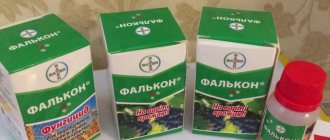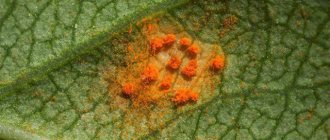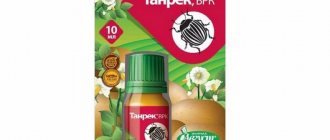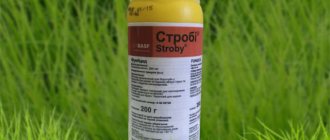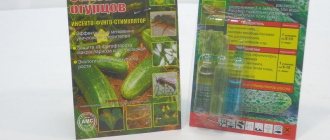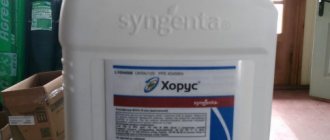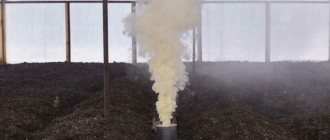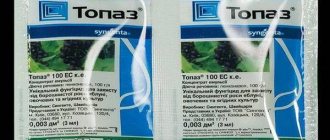The Colorado potato beetle, a well-known pest with a bright yellow-brown color and fiery orange tufts of larvae, brings a lot of troubles to gardeners. This beetle is so tenacious that homestead owners have to use chemical means of protection, no matter how sad this may be. One of the new products is “Lightning” for the Colorado potato beetle, which already has serious, balanced reviews. Before the start of the summer season, gardeners choose a product that will protect the plantings from insect invasion and at the same time be safe for humans. According to reviews, “Lightning” for the Colorado potato beetle has proven itself well, a relatively new drug with targeted action. As it is called, it works – quickly, effectively. The result is lightning fast, and most importantly, the drug can be used on different garden and vegetable crops, in accordance with the instructions.
Product Lightning principle of action, composition
“Molniya” is an insecticide of the synthetic pyrethroid class, has a contact-intestinal effect on insects, plus an acaricidal effect against various types of ticks. Such an extensive action allows the use of “Lightning” to protect field, vegetable, fruit, and flower crops from a variety of pests. The active substance causes an irreversible reaction in the insect's nerve cells, damages membranes, and blocks nerve conduction.
Composition of the drug:
- active chemical substance lambda-cyhalothrin at a concentration of 50 g/l;
- emulsion base.
The principle of operation of lambda-cyhalothrin: it penetrates into the insides of the insect along the cuticle, disrupting nerve conduction. The insect loses control over its muscles and its feeding stops. All this happens within a few minutes after the insect eats the active substance with a potato leaf. Result: paralysis occurs and the pest dies.
How to spray
The working composition should be poured into a sprayer with a pollination uniformity regulator
This is important: spray the plants evenly so that there is not more in one place and less in another. You need to study the instructions for the “Lightning” from the Colorado potato beetle in order to know how to treat potato plantings
Spraying recommendations:
- follow instructions;
- dilute the drug in the specified proportions;
- work in protective clothing;
- do not allow the chemical to come into contact with the skin;
- spray potatoes in the evening, in dry weather;
- spray during the growing season.
We must take into account possible resistance; the Colorado potato beetle easily gets used to new drugs. To prevent the population from developing a habit of “Lightning,” treatment should be alternated with other means.
Instructions for use
Each package of the chemical contains instructions for use. It describes the drug, indicates the active substance, and against which insects the product is effective. Recommendations are given for using the product against various pests on various plants. Contains rules for preparing the working solution, rules and time for spraying.
Instructions for use of “Molniya” indicate that the drug is suitable for treating all garden crops. They can be used to spray plants, shrubs, and flowers. “Lightning” is effective in destroying parasites: aphids, bedbugs, flies, cabbage moths, ticks. The drug became most effective in killing the Colorado potato beetle and rose bush pests.
Special instructions are given for the use of the working solution - spray the plants only with freshly prepared composition, moisten the plant evenly. It is better to work with a sprayer that gives a fine spray so that the solution evenly falls on the upper and lower sides of the leaves.
It is important to adhere to all recommendations given in the instructions for use of the drug
Lightning, CE
Contact-intestinal insecticide with an acaricidal effect for the protection of field, vegetable, fruit, flower crops, and green spaces from a wide range of insect pests.
general information
Contact-intestinal insecticide with an acaricidal effect for the protection of field, vegetable, fruit, flower crops, and green spaces from a wide range of insect pests.
Preparative form:
EMULSION CONCENTRATE, EC
Active ingredient, concentration:
LAMBDA-CYHALOTHRIN (50 g/l)
Chemical class: synthetic pyrethroids.
Advantages:
- Fast action, pronounced “knockdown effect”
- Effective against a wide range of pests at all stages of development, from larvae to adults, including some types of mites.
- Has a long period of protective action (more than 3 weeks)
- Convenient packaging, easy to use
- Low consumption rates and processing costs
Mechanism of action: drug of contact-intestinal action. The active substance leads to irreversible activation of sodium channels in the membranes of nerve cells and depolarization of the cell membrane, resulting in a blockade of nerve conduction in the insect.
The speed of action of lambda-cyhalothrin is very high. The substance quickly penetrates the insect through the cuticle, disrupting nerve conduction by affecting the sodium channels of the membranes of nerve cells, causing their constant activation. This leads to depolarization of the nerve cell and rapid loss of control over muscle activity. Disorientation and cessation of feeding activity occurs within a few minutes after the active substance enters the insect's body, after which a paralyzing effect occurs and the death of the pest occurs. Death from dehydration and secondary physiological changes occur over the next 24 hours.
Activity spectrum: pyrethroid insecticide, intended to protect grain, industrial, vegetable, fruit and other crops from a complex of leaf-eating and sucking pests, including mites.
Based on lambda-cyhalothrin, drugs are approved for use against pests of wheat (bread beetles, thrips, flea beetles, leafhoppers, pest bugs, aphids, leopard, cereal gall midges), barley (flies, beetle, leafhoppers, thrips, stem sawflies, aphids), corn (for grain) (cotton bollworm, corn borer), peas (pea gnat, aphids, thrips, nodule weevils), soybeans (spider mites) and many others, as well as against pests of stocks in unloaded warehouses, in grain processing areas enterprises and granaries on farms.
Speed of impact: within a few minutes after treatment, the pests become disoriented, they stop feeding, and then die as a result of general paralysis.
Terms of application: flexible terms of application. Excellent plant protection, both during planned treatments and during treatments in critical situations.
Period of protective action: at least 14 days.
Application technology: to achieve the maximum protective effect, you should strive to uniformly apply the drug to the entire surface of the treated plants.
Molniya ® is used for spraying plants during the growing season when pests appear. In order to combat pests, crops of sugar beet, rapeseed and fiber flax are treated according to the seedlings of the crop.
Treatment against locusts is carried out during the period of larval development. The period of possible stay of people in the treated areas is no earlier than 30 days after treatment; picking mushrooms and berries after spraying wild vegetation during the treatment season is not allowed.
Phytotoxicity: when used correctly and following recommended standards, it does not burn plants.
Resistance: with systematic use of this drug, resistance may occur. To avoid the development of resistance, it is necessary to alternate with insecticides of other chemical groups.
Standard packaging: 5 l canister
Additional Information
A broad-spectrum contact-intestinal insecticide with an acaricidal effect for the protection of field, vegetable, fruit, flower crops, and green spaces from a wide range of insect pests.
Hazard class: hazard class 2 (dangerous compound). Dangerous in contact with eyes and skin. It is necessary to use personal protective equipment for the skin, eyes and respiratory system.
Restrictions on transportation, use and storage of the pesticide: Combined storage and transportation of the drug with food, feed, and medicines is prohibited. Store the drug out of the reach of children and animals.
It is prohibited to work with the drug without personal protective equipment for the skin, eyes and respiratory system. Work with the drug should only be carried out by persons who have undergone special professional training. During work, it is prohibited to drink, smoke, eat, or use open fire.
Recommendations for the protection of useful objects of flora and fauna: Based on the degree of impact on aquatic biocenoses, the drug belongs to the 1st hazard class and is prohibited for use in the water protection fishery zone. The maximum permissible concentration of the drug for water in fishery reservoirs is 0.00000006 mg/l.
The drug is moderately dangerous for bees (hazard class 2). The following environmental regulations must be observed: treat plants in the evening after sunset with windiness up to 1-2 m/s; border protection zone for bees of at least 4-5 km; limiting the flight of bees to at least 7-8 days.
The use of the drug requires compliance with the basic provisions of the “Instructions for the prevention of bee poisoning by pesticides” (Moscow, Gosagroprom USSR, 1989), including timely informing beekeepers about the time, place and nature of chemical treatments. Treatment of flowering entomophilous crops during the active summer of bees, as well as subsequent visits by bees to treated farmland earlier than the established period, are not allowed. It is advisable not to cultivate fields clogged with flowering weeds (more than 3 plants per 1m2). It is necessary to mow flowering weeds along the perimeter of the cultivated field to the distance of possible drift of the drug.
First aid for poisoning: when the first signs of poisoning appear, it is necessary to remove the victim from the area of exposure to the pesticide, remove special clothing and provide access to fresh air; in case of contact with skin, carefully remove the drug with cotton wool (without rubbing it) and wash with plenty of clean water and soap; If the drug gets into your eyes, rinse immediately with plenty of clean running water; in case of accidental ingestion, give the victim a suspension of activated carbon in water (at the rate of 1 g of sorbent per kg of the victim’s body weight) and induce vomiting, then again give the victim a drink of the suspension of activated carbon in water (at the rate of 1 g of sorbent per kg of the victim’s body weight ). After providing first aid, consult a doctor. There are no antidotes. Treatment is symptomatic.
Telephone and address for emergency contact in case of poisoning: 129090 Moscow, pl. B. Sukharevskaya, 3, building 7. Federal State Institution “Scientific and Practical Toxicology Center of the Federal Medical and Biological Agency of Russia”, tel., fax.
Safety precautions during work, transportation and storage: When working with the drug, it is necessary to use personal protective equipment for the skin, eyes and respiratory system. Production premises must be equipped with supply and exhaust ventilation, and sampling sites must be equipped with local suction. In places where you work with the drug there should be a first aid kit. Those working with the drug must observe personal hygiene rules. After working with the drug, you should take a shower, change your overalls and underwear.
Transportation and storage in accordance with the requirements of OST 6-15-90.4-90, GOST 14189-81 and SanPiN 1.2.2584-10.
Transport the drug in tightly closed original containers in compliance with usual safety precautions. The drug is stored in dry, closed rooms at temperatures from minus 50C to +30C, in tightly closed original packaging.
Methods for neutralizing spilled or scattered pesticide: The spilled preparation is covered with sorbent materials (dry clay, sand, soil). The contaminated sorbent and top layer of soil are collected in a special tightly sealed labeled container, followed by neutralization in places approved by territorial environmental authorities and State Sanitary and Epidemiological Supervision agencies. Plots of land contaminated with the drug are neutralized with a 3-5% soda ash solution, and then dug up.
Methods for destruction or disposal of pesticides: Disposal of pesticide residues is carried out in accordance with the “Temporary instructions for the preparation and disposal of pesticides and their containers that are prohibited and unsuitable for use in agriculture.” (M., Agricultural Chemistry, USSR Ministry of Health, 1989).
Methods for destroying pesticide containers: Disposal of pesticide containers is carried out in accordance with the adopted “Temporary instructions for the preparation and disposal of pesticides and their containers that are prohibited and unsuitable for use in agriculture” (M., Selkhozkhimiya, Ministry of Health of the USSR , 1989).
Application regulations
Substitutes and analogues
The closest analogue of Lightning is considered to be Karate. Its active substance is also the peritroid lambda-cyhalothrin.
The drug Tanrek also effectively fights various pests of garden crops. Destroys locusts, Colorado potato beetles, and whitefly butterflies.
Mospilan can be considered a good analogue. This remedy is used against the Colorado potato beetle, weevils, and bedbugs.
When fighting the Colorado potato beetle, the drug Prestige, developed in Germany, is effective. It contains the insect repellent imidiacloprid and the antifungal agent pencycuron. This product has a third hazard class and is used in an amount of one milliliter per kilogram of potatoes.
Potatoes are treated with Prestige solution before planting: the tubers are sprayed with it in advance. The beetles, starting to eat the Prestige that has fallen into the stems, quickly die without even laying offspring. The product does not penetrate new tubers forming on the bush.
The Tabu product contains the same imidiacloprid. Protects plants from the Colorado potato beetle and other parasites, and can be used together with fungicides. The solution is prepared at the rate of eight milliliters of product per liter of water. A liter of the prepared solution is enough to process one hundred kilograms of tubers. The substances that make up the drug are able to create a thin, durable pink film around the tuber, which does not allow the insecticide to penetrate inside.
Taboo is used for treating tubers directly in planting holes, as well as for spraying bushes. When spraying a hundred square kilometers of area, it will take ten milliliters of solution containing four milliliters of the drug.
Activity spectrum
The instructions for use of the drug “Molniya” for protection against insect pests indicate that the product is suitable for use on absolutely all garden crops. It can be used for spraying plants, shrubs, and flowers. It is effective in combating parasites such as aphids, bedbugs, flies, Colorado potato beetles, and cabbage moths. It even kills ticks, which not many products can do. Therefore, it can be widely used to treat all garden plants. It gained the greatest popularity in the fight against the Colorado potato beetle and pests of rose bushes.
Safety precautions and toxicity
Toxic insecticides, which include the drug “Molniya,” require special measures to prevent poisoning. It is unacceptable to be careless when working with chemicals. When treating plantings with chemicals, you should wear special clothing to protect your body, and be sure to use bandages or masks on your face and respiratory tract. Don't forget about protective gloves and glasses.
Despite the low toxicity for humans - “Molniya” belongs to the 3rd class of toxicity for humans and to the 2nd class of toxicity for bees; it is not recommended to smoke, drink, or chew gum during processing.
For processing, it is recommended to use special containers, which must be washed thoroughly after the work, making sure that waste water does not enter the general sewer system. It needs to be specially buried in a separate place to dump the remains of hazardous and toxic substances.
As a safety measure, you should immediately take off your clothes after work, put them in the wash, and do not leave them until the next treatment. It is necessary to thoroughly rinse the respiratory tract, eyes, and wash hands with soap.
It is strictly forbidden to use “Molniya” in gardens located near natural bodies of water, since this drug destroys all aquatic biocenoses.
Security measures
Since Lightning belongs to the second class of danger to humans, certain safety measures should be followed when carrying out the spraying procedure. When processing plants, you should wear special protective clothing, gloves, goggles, as well as bandages and masks for the face and respiratory protection. During treatment, you should not smoke, eat, drink or chew chewing gum to prevent the solution from entering the body.
Separate special containers are used for the solution, which must be thoroughly washed after spraying. The water used to rinse containers should not enter the sewer system. It should be disposed of in special disposal sites for toxic waste.
Clothes should be washed immediately after spraying. In addition, you need to thoroughly rinse your eyes and respiratory tract and wash your hands with soap.
Pharmacological properties of the drug
This drug is intended to increase the resistance of the human body. “Amol” also has an anti-inflammatory, local irritant (it can have a stimulating effect on nerve endings, which ultimately improves blood supply to tissues and relieves pain), disinfectant and antiseptic effects. The essential oils included in this drug can effectively relieve pain. Amola also contains vitamin C, which promotes rapid wound healing, improvement of hematopoietic processes, synthesis of collagen and some hormones, strengthening the human body’s immune system, as well as its protection from viruses and infections. In addition, vitamin C helps the body regulate metabolism, removes toxins from it, promotes the process of separating bile and restoring the functioning of the pancreas and thyroid glands. This drug is effective in eliminating the symptoms of colds and flu, and also significantly relieves sore throat and joint diseases .
Lightning from the Colorado potato beetle description, characteristics, instructions for use
Few pests cause as many troubles for gardeners as the well-known Colorado potato beetle. Often preventive measures do not have results, and we have to resort to drastic methods and chemicals.
The drug Molniya, used by gardeners in various regions of Russia, has proven itself quite well.
Lightning from the Colorado potato beetle - description
The name of the drug quite accurately characterizes the principle of its action, which is due to the chemical composition of the product. The result is quick, and you can use Lightning not only on potatoes.
Characteristic
Lightning is part of a large group of insecticides with contact-intestinal action. It is used as a spray composition and has a wide range of effects on a wide variety of insects.
It is available in various packages, so you can always calculate how much of the drug to purchase. Lightning packages available for sale:
- ampoules, volume 2 ml;
- bottles, volume 10 ml;
- canisters, volume 5 liters.
It is very important that the product acts quickly and has a pronounced knockdown effect. Small volumes of the drug are sufficient for processing, while the low cost allows all categories of buyers to purchase the product
The Colorado potato beetle is distinguished by its survivability, adaptation to various conditions, various drugs and means. That is why gardeners are always in search of the most effective and easy-to-use preparations, and Lightning is not the last place on this list.
Compound
Lightning is based on a substance from the pyrethroid group - lambda-cyhalothrin. This is a synthetic substance that is a modification of natural pyrethroids and has an insecticidal effect.
Such substances affect the nerve cells of insects, leading to a malfunction of the nervous system, limiting the ability to move and leading to complete paralysis.
ON A NOTE! Nematodes and slugs are not susceptible to these substances.
It is important that the preparations created on the basis of these components to kill beetles (including Lightning) are low toxic to the human body. But you must follow the rules of use in any case.
Lightning contains special components that provide the product with resistance to being washed off from plants by precipitation.
Period of protective action
Thanks to a special component in the composition, Lightning causes paralysis in Colorado potato beetles. Exposure time is up to half an hour. The knockdown effect of the drug is impressive and, judging by the reviews, some gardeners did not even expect such a quick result.
Lightning retains its effect for approximately 14-21 days, but much depends on the quality of processing and weather conditions. The drug is also active during rain, but with the condition that the precipitation did not pass immediately after treatment.
How to dilute Molniya
For small areas, it is advisable to purchase packages with ampoules, as this makes it easier to dilute the product and prepare the composition.
You may be interested in:
For one hundred square meters of planting, 20 liters of the composition are required. It is diluted in the following proportions:
- Carefully dilute 2 ml of the product in two liters (one ampoule);
- then add 10 liters to the full volume, stir;
- spray potato bushes.
Thus, for 1 hundred square meters you will need two ampoules of the drug with a volume of 2 ml.
How to spray
The finished composition is poured into the sprayer, the uniform supply of the solution is adjusted
It is very important to treat the plants evenly and thoroughly, avoiding an overabundance of the drug on some bushes and a lack of it on others.
Toxicity
According to toxicity groups, Lightning is included in group 3 for humans (low-toxic drug), and in group 2 for bees (poisonous).
For processing, special containers are used; after work, they are thoroughly washed.
After processing potatoes, be sure to wash your hands and face with soapy water and change your clothes. It is recommended to wash the work clothes in which the treatment was carried out immediately.
It is not allowed to use Molniya near ponds, rivers, lakes (detrimental to all aquatic biocenoses).
Terms and conditions of storage
All shelf life is indicated on the product packaging. The solution with Lightning is prepared only before the treatment itself, accurately calculating all application rates. The drug should not be left diluted until the next treatment.
It is necessary to store ampoules or vials in a dark place, away from any food products. The product should not be accessible to children or animals.
Duration and storage rules
As mentioned above, the Lightning solution is not intended for long-term storage, so it must be prepared immediately before processing the plants, accurately calculating the amount so as not to leave residues. Unused ampoules and vials should be stored only in standard packaging, without transferring to another container, so as not to mix up the drugs. Store in a dry, cool, closed place at a temperature from minus 12 to plus 30 degrees Celsius.
The storage room for pesticides should be specially prepared, away from food products and flammable materials, in a place inaccessible to children and animals. If all conditions are properly observed, the shelf life of the drug will be up to three years from the date of manufacture.
Instructions for use
To make plant treatment more effective, spraying is recommended when the number of harmful insects exceeds the economic threshold of harmfulness. The solution must be applied in such a way that it completely covers the crop, so work should be carried out at a minimum wind speed (no more than 3 m per second).
The optimal hours for spraying are early morning or late evening. The air temperature should not be more than +20°C. The drug loses its activity in extreme heat or, conversely, in frost.
Processing of crops can be carried out during their growing season. It is allowed to spray plants no more than 2 times per season.
To prevent the emergence of resistance, it is recommended to alternate Knockout with insecticides belonging to other chemical classes, such as organophosphates.
Preparation of the solution
In order to prepare the substance, you will need a ten-liter bucket and the poison itself with a dosage of 2 milliliters. Add the contents of the ampoule to the water and stir thoroughly.
It is important to know that the amount of poison can be made larger or smaller. You need to adhere to the table located directly on the package with the drug. Everything is described in detail in it and build on it
In case of an overdose of the drug against the Colorado potato beetle, you will end up with the wrong solution, which will harm your plant and will not rid you of pests
Everything is described in detail in it and build on it. If you overdose on the drug against the Colorado potato beetle, you will end up with the wrong solution, which will harm your plant and will not get rid of the pests.
We also invite you to familiarize yourself with very effective and popular remedies for the Colorado potato beetle: Aktara, Corado, Apache, Prestige, Taboo, Commander, Tanrek, Regent.
Preparation of working solution
The working solution should be prepared immediately before the treatment procedure, since it is extremely important to comply with the shelf life of the drug. Carefully observe the amount of the drug. An area of fifty square meters will require ten liters of solution containing one two-milliliter ampoule. First, dilute two milliliters of the product in two liters of water, then add water to the end and treat the plants with the resulting solution.
See also
Description and characteristics of Zekura potato variety, planting and care rules
Read
Insecticide Lightning instructions for use
Any garden plants, as well as fruit trees, berry bushes, and flowers are treated with an aqueous solution of the Molniya insecticide. With a fairly high effectiveness of action, the drug is quite inexpensive.
General information
“Lightning,” unlike the vast majority of insecticides, kills ticks, which is very important for residents of forest areas. However, reviews show that gardeners and gardeners most often use this insecticide to combat the Colorado potato beetle on potatoes and pests that live on rose bushes
Of course, it is impossible to destroy the Colorado potato beetle as a population even in a small area. This is explained by the fact that two individuals surviving after treatment are able to quickly restore the colony to its former size. But you can’t help but fight the striped pest, and this product is well suited for this.
The active ingredient in the drug is lambda-cyhalothrin. Each liter of concentrate contains 50 grams of this substance.
Technologically, this product is an emulsion containing an adhesive substance.
Advantages
The “advantages” of the Molniya insecticide include the following qualities:
- versatility in application;
- effective defeat of adult insects and their larvae;
- the effect of the product does not weaken in rainy weather;
- the drug is not absorbed into the leaves and stems of plants;
- the period of exposure to insects lasts three weeks;
- affordable price;
- low consumption per unit area.
Effect of the drug on pests
Lambda-cyhalothrin is a contact agent that has a detrimental effect on insects at the cellular level. The functioning of the nervous system of pests is disrupted. They can neither move, nor eat, nor drink
It does not matter whether the active substance enters the insect’s digestive system or onto its body. Death occurs in both cases within a maximum of 24 hours
Rules of application
The Molniya insecticide is not used in its pure form. To protect plants from the Colorado potato beetle, you need to prepare an aqueous solution of this drug according to the following scheme:
- To prepare ten liters of an aqueous solution, it is enough to use just one 2 ml ampoule of concentrate.
- According to the norm, the contents of the ampoule should initially be diluted in one liter of water.
- Dissolve until the sediment completely disappears.
- Then add 9 liters of clean water into the container and stir again.
The solution should be used immediately after its preparation; it cannot be stored. When spraying, you must use sprayers. In this case, you need to try to treat the plants from all sides.
Treatment against aphids and other pests with an aqueous solution of the drug “Molniya” is carried out during the growing season of plants.
The emulsion contains an adhesive substance, thanks to which the solution does not evaporate from the surface of peas and other plants for a long time and is not washed off by rain. The instructions for use indicate that the effect lasts 15 days, but in practice this period is three weeks.
After the end of the period of exposure to the drug, the fruits from the plants can be removed immediately. The only exception is cabbage. It can be eaten no earlier than 10 days after the cessation of exposure to the drug.
Safety of use
The insecticide "Molniya KE" is classified as a third class of danger for people, animals and birds. For bees, this drug has a second class of danger. This means that pollinating insects die under the influence of this drug.
Spraying should be carried out only in thick protective clothing, rubber gloves, goggles and a respirator. You also need to tie a scarf around your head or wear a protective cap.
If an aqueous solution of the drug “Molniya” gets into the oral cavity, poisoning may occur. In this case, you need to rinse the stomach with water or a weak solution of manganese. Be sure to induce vomiting. Then take 3 tablets of activated carbon and go to the nearest clinic as soon as possible.
While spraying the area, there should be no unauthorized persons or pets or birds nearby.
If an aqueous solution gets on your skin, it should be washed off under a tight stream of cold water.
Store the pesticide out of the reach of children, and empty ampoules or bottles must be destroyed.
Mixing with other plant protection products
The Molniya preparation is compatible with any pesticides and insecticides, but cannot be mixed with plant protection products containing acid and alkali.
How to dilute Molniya
For small areas, it is advisable to purchase packages with ampoules, as this makes it easier to dilute the product and prepare the composition.
You may be interested in: How to treat trees and shrubs in the fall against pests and diseases. How to fight white aphids on indoor plants. How to treat the soil in a greenhouse in the fall against diseases and pests.
For one hundred square meters of planting, 20 liters of the composition are required. It is diluted in the following proportions:
- Carefully dilute 2 ml of the product in two liters (one ampoule);
- then add 10 liters to the full volume, stir;
- spray potato bushes.
Thus, for 1 hundred square meters you will need two ampoules of the drug with a volume of 2 ml.
Application regulations
| Cultivated plants | Insect pests | Processing methods | Insecticide consumption rate g/sq.m | Consumption rate of working solution ml/sq.m | Duration of protective action |
| Fruit trees, berry bushes (apple, pear, currant) | Honeyweed, flower beetle, aphid | Spraying the leaves before the flowering phase | 0,01-0,04 | 120 | 2 months |
| Cereals (wheat, barley) | bread ground beetle, beetle, pest bug | Spraying in early or middle growth phases | 0,006-0,01 | 20-40 | 1 month |
| Potatoes, tomatoes, peppers, cucumbers, eggplants | Wireworm, whitefly, aphid, Colorado potato beetle; tobacco and rose thrips | When planting potatoes, Aktor is introduced into the bottom of the furrow into the soil. Tomatoes and cucumbers are processed at the root when they reach 1 meter in height | 0,006 — 0,08 | 20-40 | from 3 to 20 days |
| Cabbage | Cabbage flies and flea beetles | Water the seedlings with the solution a few days before planting | 0,03 | 60-100 | 2 months |
| Vine | Cicadas | Spray per leaf at mid-vegetation stage | 0,01 — 0,03 | 21 day | |
| Decorative crops, flowers | Whiteflies, false scale insects, scale insects, aphids, soil flies | The working substance is introduced during the irrigation process | 0,01 — 0,04 | 10-20 | 20 days |
Application
Before manipulating the drug, you must put on special protective clothing, goggles, a respirator and gloves. You should not drink, eat or smoke while working with the drug, as there is a possibility that the poison will enter the body.
It is necessary to spray plants in calm and windless weather in order to maximally prevent the solution from getting on plants growing nearby. It is best to carry out this kind of manipulation early in the morning or in the evening (from six to ten hours).
When working, you must use a sprayer that can be adjusted (this feature ensures that the drug is evenly applied to the stems and leaves of the plant; otherwise, excessive “pouring” of poison can lead to you simply burning the crop).
Advantage of the drug:
- withstands high air temperatures;
- not washed off by rain (only if it doesn’t rain immediately after spraying);
- fast and efficient;
- long-acting;
- economical.
After you have finished working with the drug, wash your hands thoroughly with soap, rinse your mouth several times with water and change clothes.
Advantages of the drug
"Molniya" has a number of advantages due to which it has gained popularity. Let's note a few:
- works very quickly. Pests die either immediately or within a period of up to 30 minutes;
- wide range of applications;
- harms both adults and larvae;
- thanks to special additives, it is not washed off with water;
- the protection effect lasts for three weeks;
- does not penetrate plants, that is, it is not phytotoxic;
- low price and low consumption rate.
Instructions for use
Treatment of crops with Gerol solution should be carried out during the early stage of development of the pest population, when most of the larvae in it belong to the first and second instars.
It is recommended to combat locusts during the period of mass hatching and development of larvae.
It is recommended to treat orchards against codling moths and leaf miners when pests begin to lay eggs, and against leaf-eating lepidoptera - when younger caterpillars appear. To destroy the codling moth on early varieties of the crop, it is enough to carry out 1 spraying, on later varieties - 2.
Treatment of cabbage, non-fruit-bearing gardens, ornamental plantings, and forest shelterbelts against various types of pests is carried out when younger caterpillars are detected on crops.
The article was compiled using the following materials
State catalog of pesticides and agrochemicals approved for use on the territory of the Russian Federation, 2013. Ministry of Agriculture of the Russian Federation (Ministry of Agriculture of Russia)
State catalog of pesticides and agrochemicals approved for use on the territory of the Russian Federation, 2014. Ministry of Agriculture of the Russian Federation (Ministry of Agriculture of Russia) Download >>>
State catalog of pesticides and agrochemicals approved for use on the territory of the Russian Federation, 2015. Ministry of Agriculture of the Russian Federation (Ministry of Agriculture of Russia) Download >>>
State catalog of pesticides and agrochemicals approved for use on the territory of the Russian Federation, 2022. Ministry of Agriculture of the Russian Federation (Ministry of Agriculture of Russia) Download >>>
State catalog of pesticides and agrochemicals approved for use on the territory of the Russian Federation, 2022. Ministry of Agriculture of the Russian Federation (Ministry of Agriculture of Russia) Download >>>
Lightning is a pyrethroid insecticide that is designed to protect grain, industrial, vegetable, fruit and other crops from various types of leaf-eating and sucking harmful insects, including mites.
How to spray
"Lightning" is used for spraying plants. To do this, you need to dilute it in water at the rate of 2 ml per 10 liters. First stir in about a liter of water and then pour into the main container. Spray using a spray bottle. The instructions for using the “Lightning” product against the Colorado potato beetle say that to obtain an excellent protective effect, you should try to ensure that the product gets onto the entire surface of the crop. As a rule, it is necessary to spray during the growing season of plants, when the largest number of harmful insects accumulate on them.
Instructions for use of the insecticide Ivanhoe
Treatment of plants against pests is carried out during their growing season. The insecticide consumption is 0.10-0.15 liters per 1 hectare of sown area, the working solution is 200-400 liters per 1 hectare (for farmland), 5 liters per 100 sq.m (for summer cottages). Ivanhoe insecticide is effective against most pests, including specific and problematic insects at all stages of their development.
Spraying should be done in the morning or evening, in calm weather. Since the insecticide is fast-acting, precipitation that has fallen since treatment does not affect its effectiveness.
Ivanhoe can be used both on large agricultural lands and on personal plots. The frequency of treatments is 1-2 times per season, depending on the type of crop and harmful object.
Although the insecticide does not pose a threat to human health, it is low toxic to bees, however, all precautions must be taken when processing
Precautionary measures
Processing of plants is carried out only in special clothing. Socks and rubber shoes are put on your feet, and your hands are protected with gloves. The face must be covered with a special mask or a respirator and goggles used for protection. After completing work, all clothes are washed and showered. The containers containing the working solution are thoroughly washed. In this case, used water must not be allowed to enter the sewer. Remains of the drug cannot be stored. They are poured into a hole dug outside the site, in a vacant lot, and covered with earth.
While processing potato plantings, you should not be distracted, smoke, drink or eat. When an insecticide enters the body, signs of intoxication occur: dizziness, weakness, nausea, high fever. If symptoms of poisoning occur, call an ambulance and give the victim a lot of water to drink to induce vomiting.
The drug "Molniya" is low toxic to humans, but poisonous to bees. Therefore, to prevent their death, it is better to treat potatoes with an insecticide before flowering. It is also not recommended to spray the preparation on fields located close to rivers, ponds and other bodies of water.
Toxicity and precautions
The substance belongs to the third class of danger for humans and the second class of danger to bees. It can harm a person by entering his body through the skin, respiratory and digestive organs. Therefore, before starting treatment, it is necessary to cover all parts of the body - wear gloves, socks and closed shoes; You need to protect your face, for this you can use a mask, glasses and a respirator are required. Hair should be covered with a scarf or hat. If the drug gets inside, poisoning is possible, the symptoms of which are dizziness, headache, nausea, and general weakness. In the first few days, body temperature may rise to 39 degrees.
Read also: Gaupsin: instructions for use and features of use
Toxicity
When working with the drug, do not forget about its toxicity, the degree of which reaches three. Remember that although it is not particularly dangerous, it is fatal to bees, so it should not be used while the plant is in flower.
It is necessary to adhere to the specified waiting time after processing plants to avoid poisoning.
If the drug enters the body. then it is urgently necessary to rinse the stomach. To do this, drink as much warm water as possible and induce vomiting, then drink a solution prepared from water and activated carbon. If you continue to feel unwell, you will need medical help.
Purpose
Groza is a contact-intestinal insecticide whose active ingredient is metaldehyde. The pest dies 2 hours after the drug enters its digestive system, and the protective effect of the molluscicide lasts 2-3 weeks. Groza is a blue granular powder that is sold in bags of 15 and 60 g and in bottles with a capacity of 450 g. Actually, Groza is a Swiss drug Meta, which has been popular in Europe for more than fifty years, and still nothing is better for Scientists were unable to come up with a way to destroy shellfish. In addition to the active substance, Groza contains additives that repel birds and attract shellfish. Thunderstorm is used to protect vegetables, citrus fruits, berries, fruit and flower crops.
Instructions for use of the product Lightning from the Colorado potato beetle
The leaves and tops of potatoes, the tubers of which are boiled, baked, fried, put in salads and soups, are destroyed by the striped pest. To get rid of it, the bushes are sprayed using a special remedy for the Colorado potato beetle.
The drug Molniya copes with both larvae and adults. The insecticide does not quickly become addictive to the insect, which quickly adapts to various conditions and chemicals. Most poisons on the body of this pest cease to act after repeated use.
Description of the product
The active component of the drug Molniya is alpha-cypermethrin. This synthetic substance paralyzes pests, destroying their nervous system. The insecticide, falling on the plant, is absorbed into the leaves.
When the Colorado potato beetle eats green mass, the drug penetrates the insect’s body, activates the channels of cell membranes, as a result of which nerve conduction is affected and the muscular system stops performing its functions.
An adult, having tasted Lightning, dies within 20 minutes; the larvae can survive for a day. The insecticide is packaged in different containers:
- in bottles of 10 milliliters;
- in ampoules (2 ml);
- in canisters (5 l).
An annotation is attached to each product package. The owner of a garden or field selects the required amount of the drug for processing potatoes.
Lightning is combined with pesticides used for spraying agricultural crops, but is not mixed with preparations that contain a high percentage of acids and alkalis, since the effect of the insecticide is impaired.
The secret to efficiency
After eating leaves in which alpha-cypermethrin has been absorbed, the muscles of the Colorado potato beetle become paralyzed, it stops moving and falls to the ground in just a few minutes.
After treating the area with Lightning, which belongs to the third class of danger, pests appear on the bushes no earlier than 3 weeks later.
Compared to other products, the insecticide has clear advantages:
- It works quickly and for a long time.
- Does not lose effectiveness after rain.
- Can withstand heat well.
- Used sparingly.
The disadvantages of the Molniya drug include high toxicity to beneficial insects that pollinate plants. Due to repeated use, pests are able to develop resistance to the main substance present in the chemical. To prevent this from happening, you need to change the means.
What insects does it work against?
The insecticide protects garden trees, shrubs, vegetables and grain crops from ticks, caterpillars, and fights aphids, bark beetles, and sawflies.
When spraying cabbage with Molniya, the following die:
- cruciferous flea beetles;
- mole;
- scoop;
- runaway.
One treatment for such a vegetable crop is enough for a month. The insecticide destroys codling moths, leaf rollers, and spider mites on apple trees, gooseberries, raspberries, strawberries, and grapes. The product is effective in the fight against weevil, rapeseed flower beetle. To protect against the Colorado potato beetle, Lightning is sprayed on tomatoes and eggplants.
Active substance and formulation
The drug contains only one substance - lambda-cyhalothrin at a rate of 50 g/l. According to its chemical composition, it belongs to pyrethroids; in nature, it is pyrethrins. Pyrethroids are part of a group of insecticides that are so named because of their structural and biochemical similarities to naturally occurring pyrethrins. They occur naturally in the flowers of some chamomile varieties and have been used as insecticides, or pest control agents, since the 1500s. Later, their chemical composition was studied and synthetic pyrethroids were created. For household use, Molniya is available in 2 ml ampoules or 10 ml bottles. For large volumes of processing, five-liter canisters of concentrated emulsion are available for sale.

